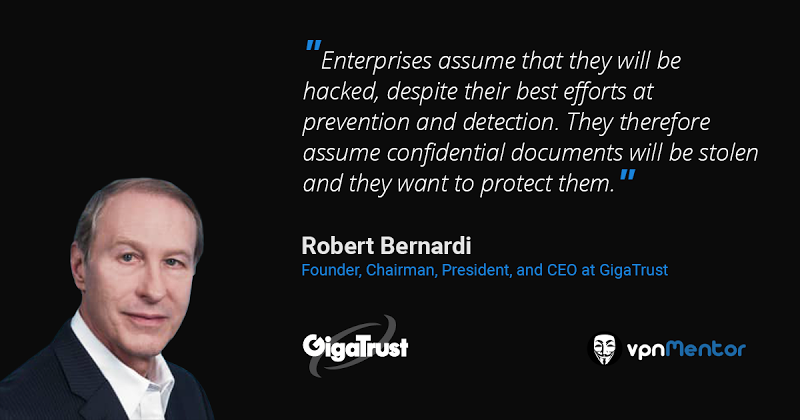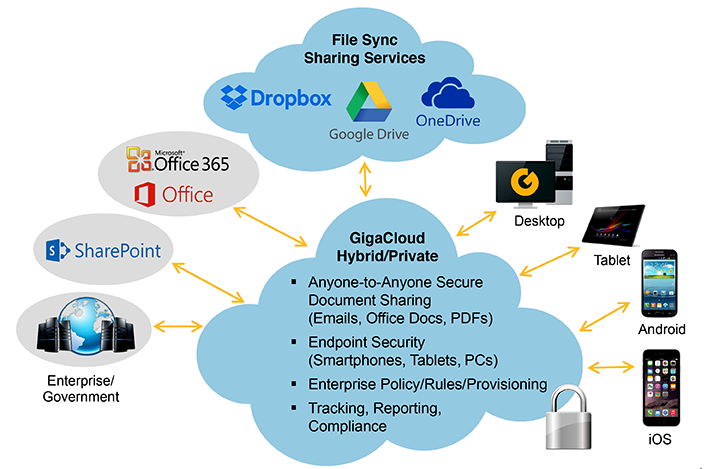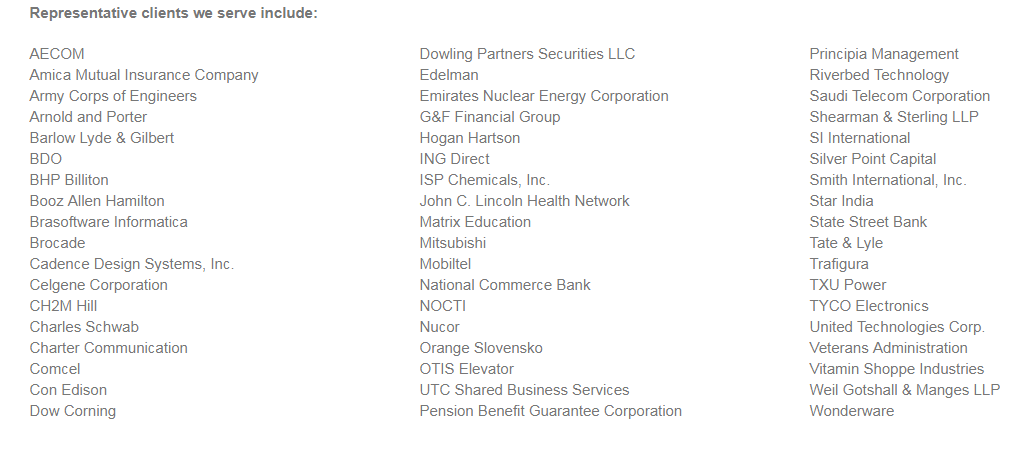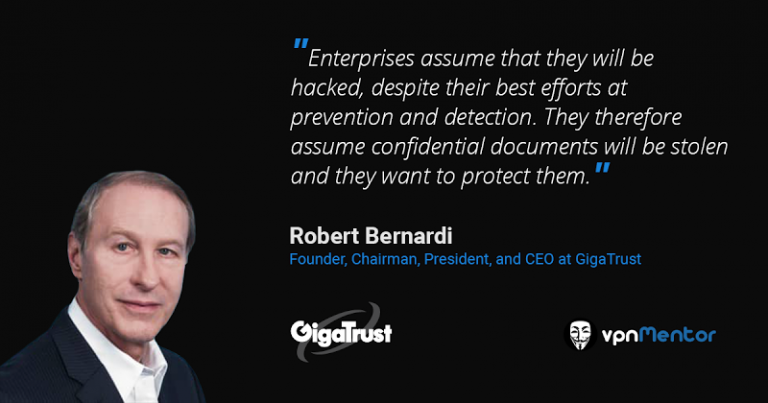
GigaTrust – Keeping Your Emails and Documents Safe
- Please tell me a little bit about yourself and your background.
- Can you please give me an overview of GigaTrust’s GigaCloud service?
- The approach you have taken is to focus on securing the documents, rather than to focus on securing the perimeter. Why is that?
- Another thing that I noticed right away about your service is that it is very Microsoft-centric. It is even based on Microsoft’s Active Directory for managing authentication and authorization. Why limit your market?
- You also have Data OverWatch? What exactly does it do?
- How do you define your market? Who is your specific target audience within that market?
- How would you describe your current typical customer?
- Who are some of your biggest customers?
- What methods do you normally use to attract and engage with new customers?
- How do you see corporate security and corporate security market evolving in the next few years?
- What are your future plans for GigaTrust?
- How many employees do you have today? Where are they located?
The vast majority of our confidential information today is stored in emails and in documents. That is why GigaTrust is dedicated to making it both easy and safe to share these documents. Their GigaCloud collaboration platform not only encrypts emails/documents at rest and in transit, but also provides in use protection by manually or automatically applying usage rights
In this interview with Robert Bernardi, the founder, chairman, president, and CEO of GigaTrust, we not only discuss the GigaCloud cloud-based service as it exists today, but also how it is going to evolve in response to the changes in the security landscape.
Please tell me a little bit about yourself and your background.
I have both a technical background and a Master’s degree. I started my career as a consultant at Booz Allen and was then at MCI in its early days (1980’s). I left there in 1984 to begin my entrepreneurial trek. I continued in the telecommunications field and founded a company that made multiplexers. I took the company public and then sold it.
In the early 1990’s I was Chairman and CEO of a software company named TREEV for 6-7 years that I also took public and subsequently sold. In the late 1990’s I was the co-founder, CEO, and Chairman of the Board of MusicMaker.com. This was during the time when (the original, peer-to-peer) Napster was on its way out. We created custom CDs from our library of close to a million songs that we licensed from major publishers. This company also went public.
I have been with GigaTrust for 14 years. For the past 10 years, I have served as the CEO, overseeing the strategic direction, operation and growth of the company.
Can you please give me an overview of GigaTrust’s GigaCloud service?
Our GigaCloud is a SaaS (Software as a Service) offering that provides secure email and document collaboration services anytime, anywhere, and on virtually any device, along with real-time data analytics, reporting and administrative tools. This goes well beyond just file synchronizing and sharing – we protect the emails and documents via both encryption and rights (permissions) management and with our private cloud options, the customer exclusively holds their private key.
The approach you have taken is to focus on securing the documents, rather than to focus on securing the perimeter. Why is that?
We take this approach because we learned that there are two main scenarios for security problems inside an enterprise:
- Information goes out - Confidential information is sent out from the enterprise, without being properly protected (i.e. encrypted).
- Hackers come in - Enterprises assume that they will be hacked and the data is subsequently breached, despite their best efforts at prevention and detection. They therefore assume confidential documents will be stolen and they want to protect them.
Our system is easy to use and a company can be up and running in a day. We offer both privately hosted and shared cloud options, which cost $3/user/month and $2/user/month, respectively. In situations where enterprise information must be shared with outside parties - which is very easy with our cloud architecture - there is no additional fee for the outside parties.
Another thing that I noticed right away about your service is that it is very Microsoft-centric. It is even based on Microsoft’s Active Directory for managing authentication and authorization. Why limit your market?
Microsoft is the dominant player in the in-use document protection market, with 60-70% of the market. Every PC since 2007 has had Microsoft’s RMS (Rights Management Services) build into the system, regardless of whether or not it is actually used.
We sell to Microsoft-centric companies, but we do not compete with Microsoft – we are Microsoft partners. We focus on filling in the features and capabilities that Microsoft does not provide, such as:
- Protect/consume Adobe PDF files on the desktop as well as text and image files rendered in native applications
- IMAP email support
- Android, and iOS Apps that protect and consume protected content with granular rights.

You also have Data OverWatch? What exactly does it do?
In addition to our desktop and mobility components, Data Over Watch is an additional component of GigaCloud that provides measurement, auditing, tracking and analytics of data content. It consists of an agent residing on endpoint devices that records every transaction (i.e. creating or consuming a protected document), and updates the central database. On the other end, there is a set of server-side tools for administrators to set rules and policies, monitor what is going on, and verify proper document protection.
How do you define your market? Who is your specific target audience within that market?
Any enterprise with confidential information is a prime candidate for our software. Having said that, there are certain verticals that naturally have a greater need, such as:
- Healthcare
- Pharmaceuticals
- Banking and Financial Services
- Manufacturing
- Energy
- Government
- Defense Agencies
These industries are characterized by the fact that in addition to having confidential data, they also have regulatory requirements and are subject to huge fines if any confidential information leaks out.
How would you describe your current typical customer?
We have highly recognized customers all over the world and they typically have a minimum of several thousand employees.

Who are some of your biggest customers?
Our current biggest customer is the US Veterans Association, which has 250,000 users.
What methods do you normally use to attract and engage with new customers?
Our two main sources of leads and new customers are Microsoft and security industry events. In addition, we also run ongoing social media marketing initiatives, including Twitter, LinkedIn, and email.
How do you see corporate security and corporate security market evolving in the next few years?
To begin with, it is crucial to acknowledge the ever-evolving nature of the landscape. Enterprises and security firms have come to recognize the inadequacy of existing methods in deterring intrusions. Consequently, the emphasis has shifted towards securing endpoints. Companies are making significant investments in a wide range of solutions, aiming to address various user scenarios. Regrettably, the situation still resembles an untamed frontier, which poses perhaps the most pressing challenge for IT departments in the present day.
What are your future plans for GigaTrust?
We want to be a dominate player in the Enterprise Rights Management (ERM) market. We are already slowly moving into the SMB (Small and Medium Business) market.
We are also working on a solution for the social media market. Today we cover both business-to-business and business-to-consumer (e.g. bank statements to customers) markets. Our social media product, which we plan to launch by the end of 2017, will be our entry into the consumer-to-consumer market – which is a huge market.
How many employees do you have today? Where are they located?
We currently have 75 employees at our headquarters here in Herndon, Virginia.


